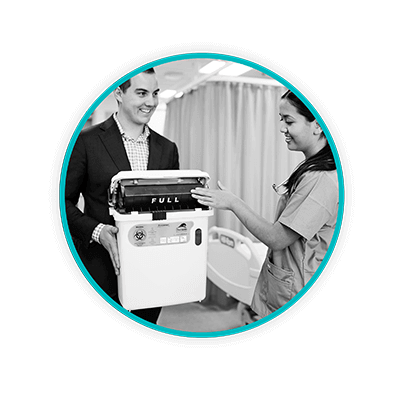Biohazardous Waste Management in Austin

There are over two dozen Urgent Care centers and major hospitals located in the city of Austin, Texas. That doesn’t even count the hundreds of affiliated physician’s offices, outpatient, cancer, and cardiac care centers serving Austin and surrounding community residents.
How do Austin medical waste management codes deal with all that healthcare-related medical waste?
Healthcare providers and facilities in Austin must follow the same rules for medical waste management as every other city in Texas. It’s not just about properly segregating medical waste, but also knowing how to handle, manage, and dispose of biohazard waste.
Biohazard waste management in Austin means following local, state and federal guidelines. If not, you run the risk of fines and penalties, not to mention loss of reputation; a literal black eye for any medical provider in this eclectic and vibrant city.
How does Austin keep track of medical waste?
Daniels Health provides Texas healthcare providers with resources and solutions for various types of medical waste, from the hospital level to your local dental office or veterinary facility. Every waste stream – every type of waste – produced by hospitals, medical offices, and healthcare specialty properties in Austin must adhere to environmentally significant regulatory requirements.
Failure to observe such regulations can get you and your facility into trouble with the Texas Commission on Environmental Quality (TCEQ), the Environmental Protection Agency (EPA), along with a myriad of other state and federal regulatory agencies.
Austin and other cities and towns throughout Texas, large or small, must classify waste. In other words, each waste stream or type of waste that is generated must undergo what is called in Texas as a “waste determination”, a process which identifies different waste streams that your facility (medical, healthcare, veterinary, dental, etc.) may generate. Only then can classification of each waste type be appropriately targeted.
Throughout Texas, and likewise in Austin, medical waste management places much of the responsibility on generators. The majority of medical waste generators are either considered small quantity generators or large quantity generators. A generator in this case is defined as the point of origin for waste. The TCEQ provides specific information about generator status, the poundage of hazardous waste “allowed” on a monthly basis, and restrictions regarding accumulation time limits on their website.
All medical waste generators in Texas, and especially in large cities like Houston, Austin, and San Antonio, must classify their medical waste, as required by the TCEQ. So too is the disposal of certain types of waste at an authorized facility.
Medical waste generators are responsible for Austin medical waste management
Austin healthcare providers and facilities must also, per Texas Administrative Code regulations, register with the TCEQ if they’re a small or large quantity generator. Do you (small and large medical waste generators) know your additional responsibilities regarding medical waste management based on the Texas Administrative Code (TAC)? We do. For example:
- You must submit annual waste summaries if your facility generates more than 220 pounds of Class I waste every month. (Refer to TAC regulations). Small and large quantity generators are required to always submit an annual waste summary.
- You must submit a notice of registration.
- You must maintain a manifest.
- You must document source reduction and waste minimization.
- You must comply with land disposal restrictions.
- You must take preparedness and prevention measures (large quantity generators are required to make arrangements with local authorities in the event of accidents, large spills, and other incidents that may prove hazardous to the general public).
- You must develop contingency plans and emergency procedures. Small quantity generators are required to have emergency procedures in place while large quantity generators are required to develop a written contingency plan.
- You must train personnel. Large quantity generators, in addition to adequate training, are required to maintain job descriptions.
- You must label containers.
- You must inspect container storage areas weekly.
- You must document air emissions – while this is not required of very small quantity generators and small quantity generators, it is required of large quantity generators per federal guidelines (40 CFR Part 265 Subparts AA, BB, and CC).
- You must follow appropriate closure procedures – this is applicable to hazardous tanks. Small quantity generators must follow federal guidelines (40 CFR 265.201(f), and large quantity generators must follow federal guidelines 40 CFR 265.197.
Federal guidelines are specific regarding proper medical waste management are specific and detailed. All states must follow all federal and state guidelines. Additional legislation guidelines of the Resource Conservation and Recovery Act (RCRA) are also applicable. Failure to comply results in hefty fines amounting to tens of thousands of dollars a day until the issue is resolved.
Unfortunately, the state of Texas has experienced a number of RCRA violations in the recent past; lack of proper container labeling, open containers, training violations, failure to perform weekly container inspections, and a number of other required processes including submission of annual waste summary and waste minimalization violations.
Are you separating your biohazard waste streams?
The TCEQ provides an easily accessible guideline for classification and coding of Industrial and Hazardous Wastes. Don’t be overwhelmed – the EPA has a listing of over 400 wastes (!) currently listed as hazardous. To more easily identify hazardous waste produced at your healthcare facility, ask yourself four basic questions:
- Is it ignitable or easily flammable, like a solvent?
- Will it react to or produce a chemical reaction?
- Is it corrosive?
- Is it toxic?
In Austin, Texas, an eight digit waste code identifies each waste stream. For further information, review Texas Administrative Code 30 Section 335.503 (Waste Classification and Waste Coding Required).

Daniels Health supports compliance – Do you?
Austin, Texas is a great city with wonderful people. Our focus is to keep healthcare workers as safe as possible and protect the environment and the general public from hazardous medical waste. When it comes to Austin medical waste management regulations, follow the rules, stay in compliance, and most importantly, take advantage of education and resources that will ensure that you do. For more information about Daniels Health and what we can do for you, contact us today.
Let's Talk!
Your time is valuable, and we don’t want to play hard to get. You can either phone us directly on the details listed on our contact page, or feel free to fill out this short form and one of our team members will get back to you as quickly as possible.
